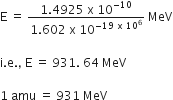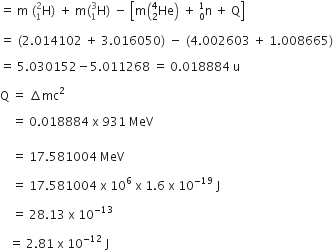What is meant by the mass defect ?
Calculate the disintegration energy Q when a heavy nucleus of mass number A = 240 with binding energy/nucleon ~7.6 MeV is split into two equal fragments of mass number A' = 120, each with BE/nucleon ~8.5 MeV.
Mass defect : The difference between the sum of the mass of the nucleons constituting a nucleus and the rest mass of the nucleus is known as mass defect.
It is denoted by  m.
m.
Δm = sum of mass of nucleons - mass of nucleus.
Given,
Mass No. of heavy nucleus is A = 240 , and
binding energy/nucleon = 7.5 MeV
Therefore,
Total binding energy of nucleus = 240 x 7.6 Mev
= 1824 MeV
It splits into two nuclei of Mass No. A1 = 120.
Therefore,
Binding energy per nucleon = 8.5 MeV
∴ Total binding energy of two nuclei = 2 x 120 x 8.5 MeV
= 2040 MeV.
∴ Disintegration energy Q = 2040 - 1824 MeV
Q = 216 MeV









